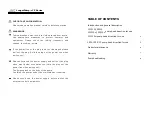
1-3
purged and filled with non-flammable gas prior
to abdominal surgery.
•This unit is equipped with the Aspen Return
Monitor (A.R.M.) which verifies that the return
electrode cable is unbroken and connected to the
return electrode and to the electrosurgical unit
when in Single Pad mode. It DOES NOT verify
that a single pad return electrode is in contact
with the patient. When in Dual Foil Pad mode,
the A.R.M. confirms that the total resistance is in
the expected range. Do not depend solely on the
Resistance Indicator in the Dual Foil Pad mode.
Proper application and visual inspection are
required for safe operation.
•The use and proper placement of a return elec-
trode is a key element in the safe and effective use
of electrosurgery in monopolar procedures, par-
ticularly in the prevention of burns. Follow direc-
tions and recommended practices for the prepara-
tion, placement, use, surveillance, and removal of
any return electrode supplied for use with this
electrosurgical unit.
•Apply the return electrode to a clean-shaven
surface of the patient that is thoroughly clean and
dry. Avoid placement on scar tissue, bony promi-
nences or other areas where pressure points on
small areas might develop.
•Because of the risk of burns, needles should
never be used as return electrodes for electro-
surgery. Return electrodes should be placed such
that as much of their conductive area as possible
is in firm contact with an area of the patients’
body that has a good blood supply and as close to
the operative site as is practical. Adhesive-type
return electrodes should be reliably attached with
their entire area in contact with the patients’ body.
•In general, electrosurgical current paths should
be as short as possible and should run either lon-
gitudinally or in a diagonal direction to the body,
not laterally and under no circumstances lateral to
the thorax.
•Electrodes and probes of monitoring, stimulat-
ing, and imaging devices can provide paths for
high frequency currents even if they are battery
powered, insulated or isolated at 60 Hz. The risk
of burns can be reduced but not eliminated by
placing the electrodes of probes as far away as
possible from the electrosurgical site and the
return electrode. Protective impedances incorpo-
rated in the monitoring leads may further reduce
the risk of these burns. Needles should not be
used as monitoring electrodes during electrosurgi-
cal procedures.
•The active electrode should not be used in the
vicinity of electrocardiograph electrodes.
•Heat applied by thermal blankets or other
sources is cumulative with the heat produced at
the return electrode (caused by electrosurgical
currents). Risk of a patient injury may be mini-
mized by choosing a dispersive electrode site that
is remote from other heat sources.
•When using injection cannulas as electrocardio-
graph electrodes, the metal cone must not be
placed on the skin; this also applies to the leads to
monitoring instruments.
•During the use of this RF isolated output unit,
the patient should not be allowed to come in con-
tact with metal parts that are grounded or other
conductive surfaces that have an appreciable
capacitance to ground. This will minimize the
possibility of localized burns resulting from stray
electrosurgical currents to the ground.
•Skin to skin contacts, such as between the arm
and the body of a patient, should be avoided by
the insertion of a cloth.
•The use of electrosurgery on patients with car-
diac pacemakers or pacemaker electrodes is poten-
tially hazardous because the pacemaker may be
irreparably damaged and/or the high frequency
energy of the electrosurgical output may interfere
with the action of the pacemaker and ventricular
fibrillation may occur. Precautions should be
taken to ensure that the patient’s well-being is
maintained in the event of such interference. We
recommend that the Cardiology Department and
the manufacturer of the pacemaker be consulted
for advice before operating on a patient with a
pacemaker. These precautions also apply to oper-
ating room personnel with cardiac pacemakers.
•To minimize the possibility of cardiac pacemaker
interference, place the return electrode such that
the electrosurgical current path is as near orthog-
onal as possible to the pacer lead.
Summary of Contents for sabre 180
Page 1: ...Service Manual...
Page 6: ...This page intentionally left blank...









































